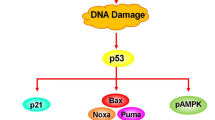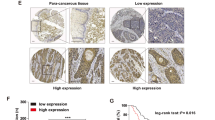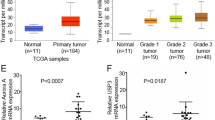Abstract
Esophageal squamous cell carcinoma (ESCC) is one of the most malignant tumors in east Asia. However, the molecular mechanism underlying its progression remains unclear. The ubiquitin–proteasome system (UPS) is a central mechanism for protein degradation and turnover. Accumulating evidence showed that more and more deubiquitinases could serve as attractive anti-cancer target. The expression of USP14 and UCH37 in esophagus squamous cell carcinoma tissues were examined by immunohistochemistry and western blot assays. Effect of b-AP15, a USP14 and UCH37 inhibitor, on ESCC cell growth was evaluated by cell viability assay. After cell lines being treated with b-AP15, cell cycle, apoptosis and the expression of related proteins were further explored to investigate the anti-ESCC mechanism of b-AP15. Results showed that deubiquitinating enzymes (DUBs) USP14 and UCH37 expressed at higher levels in ESCC tissues than in adjacent tissues. b-AP15 could inhibit cell proliferation and induce G2/M cell cycle arrest and apoptosis in ESCC cells. Mechanistically, b-AP15 treatment triggered Noxa-dependent apoptosis, which was regulated by c-Myc. Silencing Noxa and c-Myc could reduce b-AP15-induced apoptosis in ESCC cells. Our results revealed a novel mechanism of anti-tumor activity of b-AP15 in ESCC, and b-AP15 could be used as a potential therapeutic agent in ESCC.






Similar content being viewed by others
Data availability
Data sharing not applicable to this article as no datasets were generated or analyzed during the current study.
Abbreviations
- ESCC:
-
Esophageal squamous cell cancer
- UPS:
-
Ubiquitin–proteasome system
- DUBs:
-
Deubiquitinating enzymes
- USP14:
-
Ubiquitin-specific peptidase 14
- UCH37:
-
Ubiquitin C-terminal hydrolase 37
- IHC:
-
Immunohistochemistry
- DAB:
-
3,3′-Diaminobenzidine tetrahydrochloride
- ROS:
-
Reactive oxygen species
- ER:
-
Endoplasmic reticulum
References
Torre LA, Bray F, Siegel RL, Ferlay J, Lortet-Tieulent J, Jemal A (2015) Global cancer statistics, 2012. CA Cancer J Clin 65:87–108
Sohda M, Kuwano H (2017) Current status and future prospects for esophageal cancer treatment. Ann Thorac Cardiovasc Surg 23:1–11
Chen W, Zheng R, Baade PD, Zhang S, Zeng H, Bray F, Jemal A, Yu XQ, He J (2016) Cancer statistics in China, 2015. CA 66:115–132
Chen W, Sun K, Zheng R, Zeng H, Zhang S, Xia C, Yang Z, Li H, Zou X, He J (2018) Cancer incidence and mortality in China, 2014. Chin J Cancer Res 30:1–12
Belkhiri A, El-Rifai W (2015) Advances in targeted therapies and new promising targets in esophageal cancer. Oncotarget 6:1348–1358
Codipilly DC, Qin Y, Dawsey SM, Kisiel J, Topazian M, Ahlquist D, Iyer PG (2018) Screening for esophageal squamous cell carcinoma: recent advances. Gastrointest Endosc 88:413–426
Rustgi AK, El-Serag HB (2014) Esophageal carcinoma. N Engl J Med 371:2499–2509
Hall TM, Tetreault MP, Hamilton KE, Whelan KA (2018) Autophagy as a cytoprotective mechanism in esophageal squamous cell carcinoma. Curr Opin Pharmacol 41:12–19
Selvaraju K, Mazurkiewicz M, Wang X, Gullbo J, Linder S, D’Arcy P (2015) Inhibition of proteasome deubiquitinase activity: a strategy to overcome resistance to conventional proteasome inhibitors? Drug Resist Updates 21–22:20–29
de Poot SAH, Tian G, Finley D (2017) Meddling with fate: the proteasomal deubiquitinating enzymes. J Mol Biol 429:3525–3545
D’Arcy P, Wang X, Linder S (2015) Deubiquitinase inhibition as a cancer therapeutic strategy. Pharmacol Ther 147:32–54
Chen YJ, Wu H, Shen XZ (2015) The ubiquitin-proteasome system and its potential application in hepatocellular carcinoma therapy. Cancer Lett 379:245–252
Wang Y, Wang J, Zhong J, Deng Y, Xi Q, He S, Yang S, Jiang L, Huang M, Tang C, Liu R (2015) Ubiquitin-specific protease 14 (USP14) regulates cellular proliferation and apoptosis in epithelial ovarian cancer. Med Oncol 32:379
Zhu L, Yang S, He S, Qiang F, Cai J, Liu R, Gu C, Guo Z, Wang C, Zhang W et al (2016) Downregulation of ubiquitin-specific protease 14 (USP14) inhibits breast cancer cell proliferation and metastasis, but promotes apoptosis. J Mol Histol 47:69–80
Zhu Y, Zhang C, Gu C, Li Q, Wu N (2016) Function of deubiquitinating enzyme USP14 as oncogene in different types of cancer. Cell Physiol Biochem 38:993–1002
Chen X, Wu J, Chen Y, Ye D, Lei H, Xu H, Yang L, Wu Y, Gu W (2016) Ubiquitin-specific protease 14 regulates cell proliferation and apoptosis in oral squamous cell carcinoma. Int J Biochem Cell Biol 79:350–359
Zhang B, Li M, Huang P, Guan XY, Zhu YH (2017) Overexpression of ubiquitin specific peptidase 14 predicts unfavorable prognosis in esophageal squamous cell carcinoma. Thorac Cancer 8:344–349
Vogel RI, Pulver T, Heilmann W, Mooneyham A, Mullany S, Zhao X, Shahi M, Richter J, Klein M, Chen L et al (2016) USP14 is a predictor of recurrence in endometrial cancer and a molecular target for endometrial cancer treatment. Oncotarget 7:30962–30976
Liao Y, Xia X, Liu N, Cai J, Guo Z, Li Y, Jiang L, Dou QP, Tang D, Huang H, Liu J (2018) Growth arrest and apoptosis induction in androgen receptor-positive human breast cancer cells by inhibition of USP14-mediated androgen receptor deubiquitination. Oncogene 37:1896–1910
Zhang J, Zhang D, Sun L (2017) Knockdown of ubiquitin-specific protease 14 (USP14) inhibits the proliferation and tumorigenesis in esophageal squamous cell carcinoma cells. Oncol Res 25:249–257
Liao Y, Liu N, Hua X, Cai J, Xia X, Wang X, Huang H, Liu J (2017) Proteasome-associated deubiquitinase ubiquitin-specific protease 14 regulates prostate cancer proliferation by deubiquitinating and stabilizing androgen receptor. Cell Death Dis 8:e2585
Fang Y, Shen X (2017) Ubiquitin carboxyl-terminal hydrolases: involvement in cancer progression and clinical implications. Cancer Metastasis Rev 36:669–682
Chen Y, Fu D, Xi J, Ji Z, Liu T, Ma Y, Zhao Y, Dong L, Wang Q, Shen X (2012) Expression and clinical significance of UCH37 in human esophageal squamous cell carcinoma. Dig Dis Sci 57:2310–2317
Wang L, Chen YJ, Xu K, Wang YY, Shen XZ, Tu RQ (2014) High expression of UCH37 is significantly associated with poor prognosis in human epithelial ovarian cancer. Tumour Biol 35:11427–11433
Fang Y, Fu D, Tang W, Cai Y, Ma D, Wang H, Xue R, Liu T, Huang X, Dong L et al (2013) Ubiquitin C-terminal hydrolase 37, a novel predictor for hepatocellular carcinoma recurrence, promotes cell migration and invasion via interacting and deubiquitinating PRP19. Biochim Biophys Acta 1833:559–572
Zhou Z, Yao X, Pang S, Chen P, Jiang W, Shan Z, Zhang Q (2018) The deubiquitinase UCHL5/UCH37 positively regulates Hedgehog signaling by deubiquitinating Smoothened. J Mol Cell Biol 10:243–257
Randles L, Anchoori RK, Roden RB, Walters KJ (2016) The Proteasome ubiquitin receptor hRpn13 and its interacting deubiquitinating enzyme Uch37 are required for proper cell cycle progression. J Biol Chem 291:8773–8783
D’Arcy P, Linder S (2014) Molecular pathways: translational potential of deubiquitinases as drug targets. Clin Cancer Res 20:3908–3914
Popovic D, Vucic D, Dikic I (2014) Ubiquitination in disease pathogenesis and treatment. Nat Med 20:1242–1253
Pal A, Young MA, Donato NJ (2014) Emerging potential of therapeutic targeting of ubiquitin-specific proteases in the treatment of cancer. Cancer Res 74:4955–4966
Crosas B (2014) Deubiquitinating enzyme inhibitors and their potential in cancer therapy. Curr Cancer Drug Targets 14:506–516
D’Arcy P, Brnjic S, Olofsson MH, Fryknäs M, Lindsten K, De Cesare M, Perego P, Sadeghi B, Hassan M, Larsson R, Linder S (2011) Inhibition of proteasome deubiquitinating activity as a new cancer therapy. Nat Med 17:1636–1640
Tian Z, D’Arcy P, Wang X, Ray A, Tai YT, Hu Y, Carrasco RD, Richardson P, Linder S, Chauhan D, Anderson KC (2014) A novel small molecule inhibitor of deubiquitylating enzyme USP14 and UCHL5 induces apoptosis in multiple myeloma and overcomes bortezomib resistance. Blood 123:706–716
Cai J, Xia X, Liao Y, Liu N, Guo Z, Chen J, Yang L, Long H, Yang Q, Zhang X et al (2017) A novel deubiquitinase inhibitor b-AP15 triggers apoptosis in both androgen receptor-dependent and -independent prostate cancers. Oncotarget 8:63232–63246
Oh YT, Deng L, Deng J, Sun SY (2017) The proteasome deubiquitinase inhibitor b-AP15 enhances DR5 activation-induced apoptosis through stabilizing DR5. Sci Rep 7:8027
Kropp KN, Maurer S, Rothfelder K, Schmied BJ, Clar KL, Schmidt M, Strunz B, Kopp HG, Steinle A, Grunebach F et al (2018) The novel deubiquitinase inhibitor b-AP15 induces direct and NK cell-mediated antitumor effects in human mantle cell lymphoma. Cancer Immunol Immunother 67:935–947
Sarhan D, D’Arcy P, Lundqvist A (2014) Regulation of TRAIL-receptor expression by the ubiquitin-proteasome system. Int J Mol Sci 15:18557–18573
Sarhan D, Wennerberg E, D’Arcy P, Gurajada D, Linder S, Lundqvist A (2013) A novel inhibitor of proteasome deubiquitinating activity renders tumor cells sensitive to TRAIL-mediated apoptosis by natural killer cells and T cells. Cancer Immunol Immunother 62:1359–1368
Chen P, Hu T, Liang Y, Li P, Chen X, Zhang J, Ma Y, Hao Q, Wang J, Zhang P et al (2016) Neddylation inhibition activates the extrinsic apoptosis pathway through ATF4-CHOP-DR5 axis in human esophageal cancer cells. Clin Cancer Res 22:4145–4157
Hao Q, Zhao X, Zhang Y, Dong Z, Hu T, Chen P (2017) Targeting overexpressed activating transcription factor 1 (ATF1) inhibits proliferation and migration and enhances sensitivity to paclitaxel in esophageal cancer cells. Med Sci Monit Basic Res 23:304–312
Chen P, Li M, Hao Q, Zhao X, Hu T (2018) Targeting the overexpressed CREB inhibits esophageal squamous cell carcinoma cell growth. Oncol Rep 39:1369–1377
Hu T, Zhang J, Sha B, Li M, Wang L, Zhang Y, Liu X, Dong Z, Liu Z, Li P, Chen P (2018) Targeting the overexpressed USP7 inhibits esophageal squamous cell carcinoma cell growth by inducing NOXA-mediated apoptosis. Mol Carcinog 58(1):42–54
Lin S, Shang Z, Li S, Gao P, Zhang Y, Hou S, Qin P, Dong Z, Hu T, Chen P (2018) Neddylation inhibitor MLN4924 induces G2 cell cycle arrest, DNA damage and sensitizes esophageal squamous cell carcinoma cells to cisplatin. Oncol Lett 15:2583–2589
Yeasmin Khusbu F, Chen FZ, Chen HC (2018) Targeting ubiquitin specific protease 7 in cancer: a deubiquitinase with great prospects. Cell Biochem Funct 36:244–254
Jin WL, Mao XY, Qiu GZ (2017) Targeting deubiquitinating enzymes in glioblastoma multiforme: expectations and challenges. Med Res Rev 37:627–661
Ding Y, Chen X, Wang B, Yu B, Ge J (2018) Deubiquitinase inhibitor b-AP15 activates endoplasmic reticulum (ER) stress and inhibits Wnt/Notch1 signaling pathway leading to the reduction of cell survival in hepatocellular carcinoma cells. Eur J Pharmacol 825:10–18
Feng X, Holmlund T, Zheng C, Fadeel B (2014) Proapoptotic effects of the novel proteasome inhibitor b-AP15 on multiple myeloma cells and natural killer cells. Exp Hematol 42:172–182
Vogel RI, Coughlin K, Scotti A, Iizuka Y, Anchoori R, Roden RB, Marastoni M, Bazzaro M (2015) Simultaneous inhibition of deubiquitinating enzymes (DUBs) and autophagy synergistically kills breast cancer cells. Oncotarget 6:4159–4170
Aleo E, Henderson CJ, Fontanini A, Solazzo B, Brancolini C (2006) Identification of new compounds that trigger apoptosome-independent caspase activation and apoptosis. Cancer Res 66:9235–9244
Brnjic S, Mazurkiewicz M, Fryknäs M, Sun C, Zhang X, Larsson R, D’Arcy P, Linder S (2014) Induction of tumor cell apoptosis by a proteasome deubiquitinase inhibitor is associated with oxidative stress. Antioxid Redox Signal 21:2271–2285
Knorr KLB, Schneider PA, Meng XW, Dai H, Smith BD, Hess AD, Karp JE, Kaufmann SH (2015) MLN4924 induces Noxa upregulation in acute myelogenous leukemia and synergizes with Bcl-2 inhibitors. Cell Death Differ 22:2133–2142
Wirth M, Stojanovic N, Christian J, Paul MC, Stauber RH, Schmid RM, Hacker G, Kramer OH, Saur D, Schneider G (2014) MYC and EGR1 synergize to trigger tumor cell death by controlling NOXA and BIM transcription upon treatment with the proteasome inhibitor bortezomib. Nucleic Acids Res 42:10433–10447
Acknowledgements
And the authors would also like to thank those who contributed their tissue samples to support scientific research in medical fields.
Funding
This research was funded by the National Natural Science Foundation Grant of China (Grant Nos. 81001102, 81101894, 81672421, U1604189), Natural Science Foundation of Henan Province (Grant No. 162300410302), Outstanding Young Talent Research Fund of Zhengzhou University (Grant Nos. 51999223, 32210449) and Program for Science &Technology Innovation Talents in Universities of Henan Province (Grant No. 18HASTIT046).
Author information
Authors and Affiliations
Contributions
Conceptualization, Tao Hu and Pei Li; Methodology, Beibei Sha, Xiaoyu Chen, Miaomiao Li and Longhao Wang; Validation, Beibei Sha, Xiaoyu Chen, Miaomiao Li, Longhao Wang and Han Wu; Results interpretation, Beibei Sha, Xiaoyu Chen, Miaomiao Li and Xingge Liu; Manuscript preparation: Ping Chen and Jianxiang Shi; Supervision, Tao Hu and Pei Li; Project administration, Tao Hu and Pei Li; Funding acquisition, Ping Chen, Tao Hu and Pei Li.
Corresponding authors
Ethics declarations
Compliance with ethical standards
Conflict of interest
The authors declare that they have no conflict of interests.
Ethical approval
All experiments were approved by the Institutional Review Board of Zhengzhou University.
Additional information
Publisher's Note
Springer Nature remains neutral with regard to jurisdictional claims in published maps and institutional affiliations.
Electronic supplementary material
Below is the link to the electronic supplementary material.
10495_2019_1561_MOESM1_ESM.pdf
Supplementary material 1 (PDF 1176 kb) Supplementary Figure. The effect of c-Myc on the accumulation of polyubiquitin. After transfected with the control siRNA, or c-Myc siRNA for 96 h, cell proteins were collected and knockdown efficiency and the effect of c-Myc on the accumulation of polyubiquitin were assessed by western blot analysis. GAPDH was used as loading control
Rights and permissions
About this article
Cite this article
Sha, B., Chen, X., Wu, H. et al. Deubiquitylatinase inhibitor b-AP15 induces c-Myc-Noxa-mediated apoptosis in esophageal squamous cell carcinoma. Apoptosis 24, 826–836 (2019). https://doi.org/10.1007/s10495-019-01561-9
Published:
Issue Date:
DOI: https://doi.org/10.1007/s10495-019-01561-9




